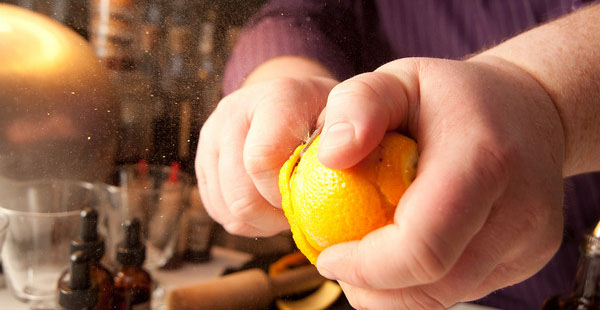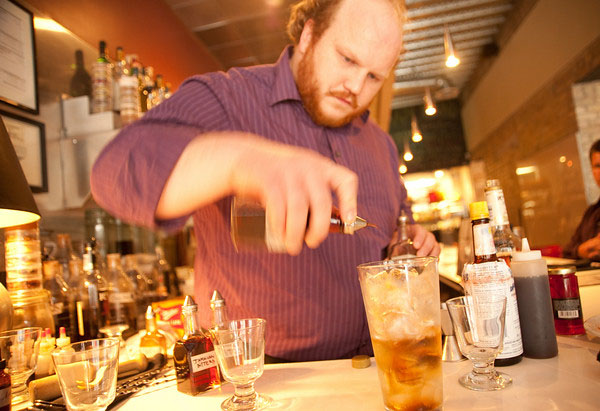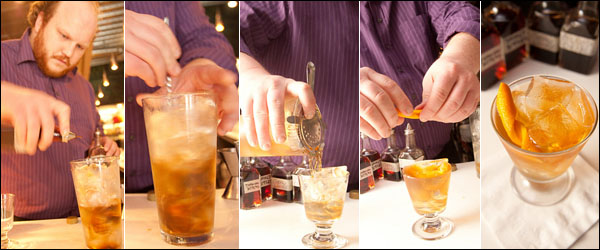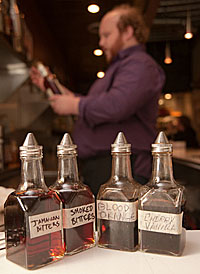Nick Kosevich is the front of the house manager for the Town Talk Diner and was named Best Bartender by City Pages in 2008. In this recurring column, he’ll share his knowledge about the origins, degeneration, and restoration of classic cocktails.

Since the dawn of history — or shortly thereafter — distilled spirits have been part of human culture. But the cocktail, a true cocktail, is a considerably newer and thoroughly American invention, imbibed for only the last 100 to 150 years. A true cocktail, a classic cocktail, is built upon basic elements and concrete recipes that date back from the late 1890s to just before Prohibition. When these recipes are followed properly, the finished cocktail grants the gift of time travel and transports the drinker back to a simpler age.
We have the classic cocktail movement to thank for the resurgence of true and original recipes of cocktails such as the Old Fashioned, the Daiquiri, and the Jack Rose. Since their creation, these cocktails have morphed into drinks that sacrifice the integrity of the initial creation on the altar of popular taste. Consider: the original Daiquiri wasn’t made with frozen ice or whipped cream. Nor was the Old Fashioned made with 7 Up or maraschino cherries.
So what happened to these recipes?

One theory suggests that Prohibition is to blame for the morphing of classic drinks. The Old Fashioned is considered a pre-Prohibition-era cocktail and the original recipes vary immensely from post-Prohibition ones. When America’s love affair with the cocktail was forced underground, the quality of the spirits consumed degraded basically to the point of poison. Cutting these spirits with fruit juices and sugar was one way the speakeasy barkeeps could get their guests to stomach the quality of product that they had to sell.
Of these classic cocktails no other has as many Midwestern devotees as the Old Fashioned — made with brandy and served in a modern bastardized incarnation, it serves as the unofficial state cocktail of Wisconsin. The Old Fashioned is a rather controversial drink — it’s a beverage of many recipes. Author and producer Crosby Gaige wrote: “Serious-minded persons omit fruit salad from ‘Old-Fashioneds,’ while the frivolous window-dress the brew with slices of orange, sticks of pineapples, and a couple of turnips.” The Old Fashioned is in the family of muddled drinks, according to Gary Regan¹, which originally only meant muddling a sugar cube into the bitters.
The words “Old-Fashioned” were used in reference to a cocktail in print in 1895 and not until 1973 did the recipe appear with fruit. Some of the older recipes for the Old Fashioned might have included Curacao and maraschino liqueurs, which is how that inedible neon red orb we call a maraschino cherry eventually came into play. Even before 1895, the basic definition of a cocktail was the original recipe of the Old Fashioned. In 1806 the word “cocktail” was first published² and was given the definition of “a potent concoction of spirits, bitters, water, and sugar. A kind of bittered sling.” All of the classic cocktail authors, including David Embury, considered the Old Fashioned to be of the utmost importance; it’s one of the six basic drinks listed in David Embury’s classic 1948 cocktail book, The Fine Art of Mixing Drinks.

Much of the modern-day Old Fashioned-related controversy can be blamed upon Wisconsinites. A Wisconsin Old Fashioned consists of 1 tsp of granulated sugar (usually a little white packet), 2 dashes of Angostura bitters, 1 ½ oz of brandy, and a splash of 7 Up. The sugar and bitters are added first with a splash of 7 Up to dissolve the sugar, then the brandy is added, and topped with ice and 7 Up to finish the drink. This version is then garnished with a flag (a bar term for an orange slice wrapped around a cherry) and picked.
The classic recipe for the drink is 1 sugar cube, 3 dashes of bitters, and 3 oz of bourbon or rye whiskey, not brandy, served in an old fashioned glass on the rocks with a lemon twist. The ingredients in this cocktail are simply softening the whiskey into a potable elixir. Whiskey was the original spirit of choice in this cocktail due to the ascent in popularity of rye whiskey over brandy in the late 19th century. At that time, insects called phylloxera were wiping out European grapes and causing the price of brandy to skyrocket. Until two brothers from Bohemia settled in California and started producing American brandy, Americans were consuming rye and bourbon far more than their sweeter counterpart.

The World’s Columbian Exposition, held in Chicago in 1893, made the Old Fashioned a staple in the gullets of Midwesterners in general and Wisconsinites in particular. The Korbel brothers had been making brandy since 1889 with little commercial success, until they brought it to this Chicago fair. They met, in the process, hordes of Germans who had settled in Wisconsin and were visiting for the event.

The German Midwesterners then took the brandy back home and ever since have been some of the largest consumers of brandy in the world. In these pre-Prohibition times these German settlers in Wisconsin used brandy for all of their cocktails instead of whiskey, creating sweeter beverages all around, a trend that has continued into the modern era. In 2004, 139,000 cases of Korbel brandy alone — a third of the total production — went to Wisconsin, helping to make the state the largest consumer (flat out, not just per capita) of brandy in the United States.
Today’s cocktail historians continue to unearth recipes that differ greatly from what we’re used to today. The classic cocktail movement has prodded many a “mixologist” to uncover over 100 years of American cocktail history. With the discovery of these antique recipes our cocktail culture finds itself in a renaissance, with bartenders all over the nation cheering the death of the Cosmopolitan and the re-birth of classics like the Old Fashioned.
Coming up next in this series: The Daiquiri
1. The Joy of Mixology, Gary Regan, 2003
2. May 6, 1806 issue of The Balance and Columbian Repository in Hudson, New York. In the May 13, 1806 issue, the paper’s editor wrote that it was a potent concoction of spirits, bitters, water, and sugar, a kind of bittered sling.

I’m so happy to have come across your site….finally a decent, honest and well-done homage to all things local and fabulous, and where necessary, the not-so fabulous as well.
You’ll be going on my own Blogroll, and in my Reader and I’m heading to Facebook to find you too. ‘Nuf said…..
Kate- Thanks for the compliments. We just added your local food blog to our sidebar as well. Thanks for reading as well as commenting!
As an ardent fan of the brandy Old Fashioned (because I cannot drink bourbon or rye without losing my mind) I prefer to see the Wisconsin incarnation of the cocktail as an appropriation rather than a bastardization.
AWESOME!! GREAT ADDITION!!
Yes. Also, please write something about ice cubes in cocktails. And glassware. You know the heft of it and stuff, the presence.
Very nice article. Though I a Brandy Old Fashioned can be a very decent drink, if you use very good ingredients [I will use today Martell XO] and if you are following an appropriate recipe [why the heck are they using 7up???].
Further I think a proper Cosmopolitan [the Dale deGroff version] a decent cocktail- if you are accepting that it is made with vodka [which is not so good].
But I got your point [and I am also not a fan of Cosmos].
No mention of the muddling of the flag with the bitters and suger? No garnish because it is already in the drink? I want more facts Nick. Great piece Nick. I think you can write.
The writer indicates that fruit was not added until 1973. Being raised in the small town of Luxemburg fruit (orange & cherry) was already in the drink in the early 60’s and this would include many of the small towns and country bars surrounding Luxemburg. For those who plan on a night of drinking this is a great drink to carry you through the night. If my memory serves me right the preferred brandy in this area was either Christian Brothers or Aristocrat. The brandy Old Fashion over a Kesslers whiskey for my taste is much better.
Hello,
Cocktail Metamorphosis….the original will never die!
Cheers from Hannover/Germany
Frank